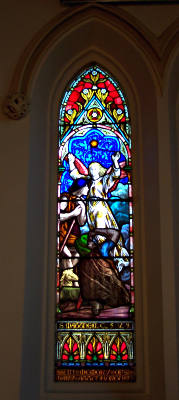Stained Glass Windows of Christ Church at Dingley
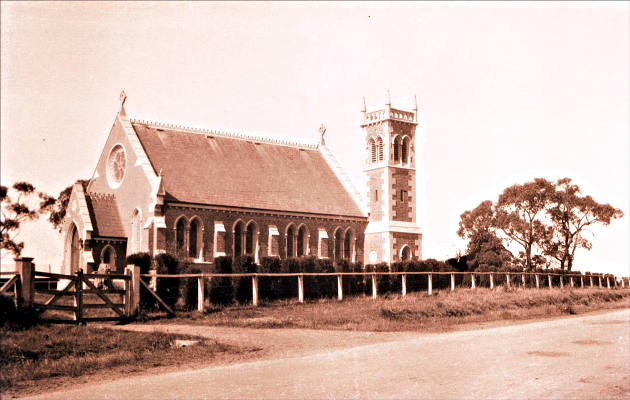
Christ Church, Dingley, c1910. Courtesy Helen Stanley.
Christ Church, Dingley designed by architect Charles Webb in an early English Gothic style was initially the dream of its benefactress Mary Attenborough. The foundation stone was laid on February 12, 1873 by the Reverend J H Gregory. The completed church was consecrated by the Bishop of Melbourne, the Right Reverend Charles Perry on September 21, 1873 and over the years since that time several stained glass windows have been added to the building.
A report of Heritage Victoria describes the windows in the nave as a substantial collection designed and produced by a number of notable practitioners including Ferguson and Urie, Brooks Robinson, William Montgomery and Rogers and Hughes. [Draft statement of Cultural Heritage Significance, Victorian Heritage Register March 2003]
In the nave of the church the windows are in pairs. The first set on the north side have the notation, To the Glory of God. In Loving Memory of William Henry Stooke also Samuel and John Kingston. This is the most recent addition to the church being erected in 1946. The subject of the left side lancet is of Jesus holding a lamb in His arms as The Good Shepherd, the other depicts the early Christian disciple Dorcas, who was well known for her works of charity.
W H Stooke was a member of the first “Committee to take care of the Church and its appurtenances," elected in 1895. Later, in 1903, he became a trustee of the Mary Attenborough Estate succeeding Thomas Attenborough who had died three years earlier.
Samuel Kingston built a brick home in 1911 adjacent to Dingley Grange, the home of the Attenboroughs. The Kingston family name, including that of John Kingston, appears many times in Christ Church records.
The second pair of windows on the north side form the memorial window. To the Glory of God And in Loving Memory of Trevlyn Armstrong 21st Batt AIF. The Gift of His Parents.
Henry Trevlyn Armstrong was born in 1895. He enlisted at Dingley on November 28, 1915, stating that he was a ‘native of Heatherton’. After basic military training at Broadmeadows, he was allotted as a reinforcement to the 21st Infantry Battalion then on its way from Gallipoli to Egypt. The 21st Battalion was part of the 6th Brigade of the 2nd Australian Division. This Division went into action in France, suffering huge casualties at Pozieres on the Somme. Later, at the first battle of Bullecourt in 1917, the battalion again sustained major casualties. In the same year the battalion was at the front line in the Polygon Wood sector of the Flanders front. The 6th Brigade attacked the Germans at Broomsiende on the morning of the 4th October, suffering horrendous casualties in the cold drizzling rain.
It was during this brutal day that Trevlyn Armstrong was killed aged 22 years. His body was recovered and buried in the British Cemetery, Polygon Wood, Belgium.
The subject of one section of the window is most unusual for a war memorial window as it shows the angelic visitation of Mary. Mary is in an anachronistic setting of prayer desk and building.
Christ Church Burial Registers record the burial of Elizabeth Harriet Armstrong on September 18, 1940 aged 75 years and Henry Armstrong buried on January 31, 1943 aged 83 years. They were the parents of Trevlyn.
There are four sets of windows associated with the Attenboroughs. The first on the north side of the church records, In loving memory of Thomas Attenborough By the congregation and his friends 1901.
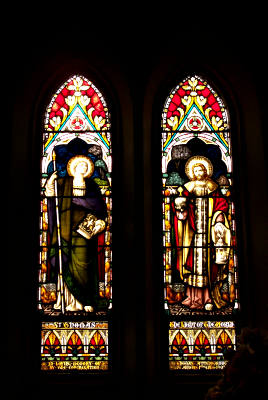
Thomas Attenborough was born in England in 1829 and emigrated to the colony of Port Phillip in 1853. Within three years he and his older sister had purchased a 170 acre property in the Parish of Mordialloc fronting Centre Dandenong Road from the original Crown grant owner, Patrick Riley, for 289 pounds. They built a family home called Dingley Grange, a name derived from Dingley Hall in Northamptonshire.
Thomas and Mary became involved in the community including active involvement in St Matthew’s Church of England, Cheltenham from 1868 to 1873. From 1864 to 1869 Thomas served on the Moorabbin Roads Board with Colonel William Mair and Thomas Bent. With others, Thomas applied for a Board of Education grant to establish a Common School, the grant was approved, the school was built , the Heatherton Primary School only closing in 1999.
Thomas served for many years on the Dandenong Shire Council before retiring in 1882. He was president of the Shire 1876-1877. He was active in supporting the Dandenong Mechanics’ Institute, the Free Trade League and was a Justice of the Peace from 1885 to 1895 as well as acting as a Magistrate on the Police Bench in Cheltenham.
In 1882 Thomas visited England and returned with a bride, formerly Miss Jane Mary Stokes. They returned to Dingley Grange and later moved to Charman Road, Cheltenham. Thomas fulfilled a promise to Mary and in 1889 had the schoolroom built at Christ Church. This is now known as Attenborough Hall.
Thomas died in 1899, aged 70 years, and is buried in the same gave as Mary in the Old Cheltenham cemetery. His widow, June Mary Attenborough later married a widower, Hugh G Mackenzie of Centre Dandenong Road.
The second set of Attenborough windows is dedicated to Mary. The inscription reads Acts C 16 v14 St Mark C14 v3 In Loving Memory of Mary Attenborough By this congregation and her friends 1877.
Mary Attenborough was born in 1819 to George and Betsy Attenborough of Blakesley, Northamptonshire . Her brothers were George, Richard, James and Thomas. Mary’s father died and her uncle Robert of Braybrooke 24 kms north of the town of Northampton, 3 kms from Dingley) became her guardian.
Settling in Dingley on land in Centre Dandenong Road, prior to the establishment of Christ Church, Mary and Thomas were known to “call together … friends for prayer on Sundays." Despite active involvement in St Matthew’s Cheltenham, Mary desired the establishment of a local church. Through her endeavours and her generosity the Reverend J H Gregory in February 1873 , laid the foundation stone and the Right Reverend Charles Perry, Bishop of Melbourne, dedicated the church on September 21, of the same year.
According to Mary’s Last Will and Testament all her land was devised to three local trustees as an endowment for “such Church of England purposes in connection with the Church now standing on Allotment 3A Section 14 (known as Christ Church Dingley) as the said trustees shall in their discretion think fit. Whenever the annual proceeds of such lands shall exceed three hundred pounds such excess shall be paid by the trustees to the endowment fund of the Church of England in Victoria."
Mary died of diabetic complications on June 22, 1876, aged 57 years. She was buried in the old Cheltenham Cemetery.
The left side of the widow depicts “a woman named Lydia, a dealer in purple cloth ,… who was a worshipper of God" listening to the apostle Paul. The other window illustrated the story of the woman with the alabaster jar of very expensive perfume expressing her devotion by anointing the head of Jesus. Maybe the illustrations were meant to symbolize the life of Mary Attenborough.
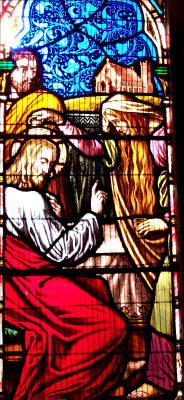
The window has the delightful but unusual inclusion of a portrayal of Christ Church. This window as erected in 1877, only four years after the opening of the church.
The three windows in the sanctuary were placed on the day of dedication of the church. In Memory of Thomas Attenborough, Robert Attenborough.
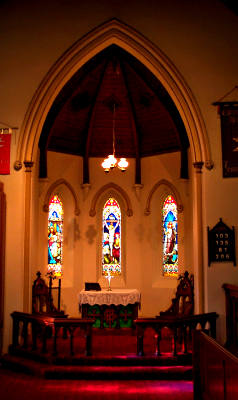
It is supposed that these windows honour Mary Attenborough’s brother, Thomas and Mary’s uncle Robert. The northern window depicts the Nativity showing Mary, Joseph, the Holy Child, shepherds and animals together with doves and the light of the guiding star. The central window depicts The Crucifixion with Jesus on the Cross, his mother Mary, another woman, and the apostle John. The side of Jesus has been pierced. The southern window depicts the moment of triumphant resurrection, with a stunned guard and a victory banner.
The four pairs of windows on the south side of the church as all in memory of Mary, each set being given by one of Mary’s brothers. The Brother George pair have the inscription St Matthew C 25 V35 in Memory of Mary Attenborough St Matthew C 25 V36 by her Brother George. There is no record of George migrating to Australia. The scripture references include the words “ I was hungry and you fed me" and “I was unclothed and you clothed me." The woman in each of these windows is a portrait of Mary Attenbough. Obviously she was recognized as a woman of compassion and practical help.
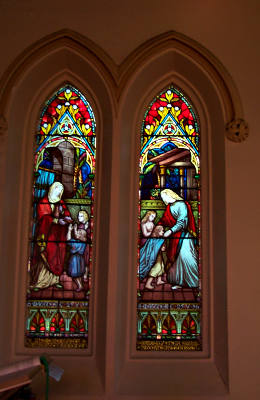
The Richard Attenborough pair on the south side of the church have the inscription St Matthew C5 v9 in Memory of Mary Attenborough St Matthew C5 v4 by her Brother Richard. There is no record of Richard’s baptism in the Blakesley Baptismal Register or of his migrating two Australia. The scripture references come from The Beatitudes and speak of the meek and humble and of the peacemakers, probably attributes of Mary.
The brother Thomas Attenborough window is engraved with St Matthew c25 v36 In Memory of Mary Attenborough. St Luke c10 v10 by her Brother Thomas. The first scripture reference says “I was ill and you looked after me" and speaks of Mary’s care for others. The second scripture refers to the story of Jesus with Martha and Mary. Again the portraits of the women in the windows are of Mary Attenborough.
The final Attenborough window is from Brother James. St Matthew c5 v3 In Memory of Mary Attenborough St Matthew c5 v8 by her Brother James. James immigrated to Victoria and lived in Fitzroy. He died in 1899, three weeks after his brother Thomas, and was buried in the St Kilda cemetery. The scripture references again come from The Beatitudes and refer to the poor in spirit and to the pure in heart. The depictions are of the angelic announcement to the shepherds and of the recognition of Jesus by Simeon in the Temple.
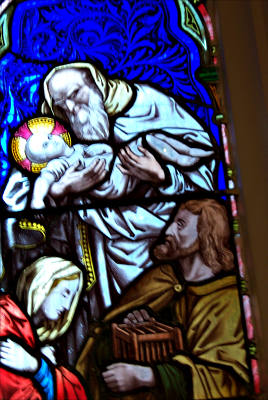
There is an intricate Rose Window above the West Door. The word in Hebrew contained in the triangle is the Tetragrammaton for the ancient Hebrew name for God – YHWH or Yahweh. The windows on either side of the West Door are the same as all original windows in the church – diamond shaped leadlight panes with a surrounding coloured border.
